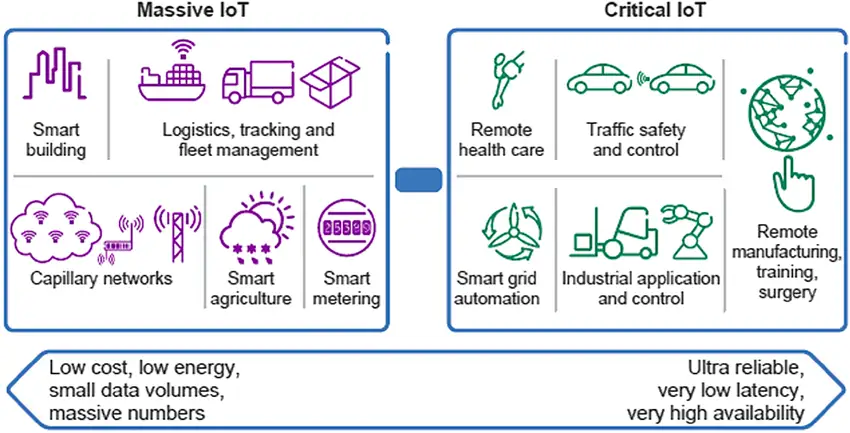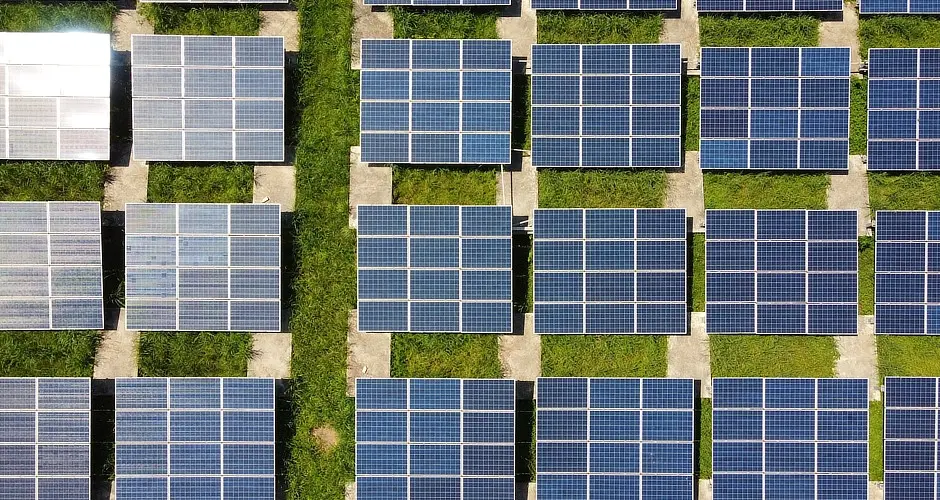Massive IoT is an orchestration of a very large number of connected devices (sensors), sophisticated connectivity and astute data processing. It collects data that provide insights to solve problems and is changing the way we do business.
It typically involves applications that are low-cost and energy-efficient. These devices are designed to handle small data volumes and are usually connected via cellular networks or low-power wide-area networks.
Think of Massive IoT as the maestro, conducting an orchestra of endless possibilities – from the nuanced art of water quality monitoring to the precise choreography of shipment tracking.
It is a connection of a massive number of devices that are low in complexity, have long battery life, and require relatively low levels of data transmission. These devices typically collect and transmit information to the cloud, enabling various applications and use cases across different sectors.
Exploring the Differences: What is Massive IoT Compared to Standard IoT?
In a single word – it’s the scale – connecting devices on a massive scale in a way that is commercially viable and effective. The scale refers both to the number of devices deployed to track, monitor or measure, but also the data that is collected.

However, at Thinxtra we firmly believe that data collection should be carefully defined at the start of a project so businesses collect only the most relevant and useful data rather than a large amount of data that then causes a new challenge of data storage, management and analysis. “Collecting and storing big amounts of data requires a lot of energy, which contributes negatively to a company’s ecological footprint” according to PWC.
What’s the difference between Massive IoT and Critical IoT?
When questioning what is massive IoT, it’s important to note that it is distinct from Critical IoT in a few ways:
- Data volume – Massive IoT is focused on collecting certain data only, that is low volumes of data for example location only, or perhaps location and temperature of a shipping container or beer keg. Critical IoT will often collect more data for example in a remote health setting a range of different data points will be collected and transmitted quickly.
- Number of transmissions – Critical IoT needs regular or even constant data transmission, whereas Massive IoT is defined by a set number of data transmissions per day. In the case of Konvoy, they only need to know the location of their rental beer kegs 2-3 times per day.
- Broad coverage – Massive IoT plays a crucial role in applications like smart cities, industrial automation, and environmental monitoring, where extensive networks of sensors and devices are required to gather and process data over large areas. Consider CouriersPlease, which tracks its parcel cages all over Australia.
- Critical IoT is reliant on the speed of the connection, therefore the connectivity solution is vital to ensure that the data is quickly transmitted such as in the case of remote health care, traffic safety and automated vehicles.
What’s driving the uptake of Massive IoT?
Rising costs
The cost of doing business keeps rising – from the cost of raw materials and resources, to electricity and gas and also the cost of staff and skills.
According to KPMG, 71% of global companies highlight raw material costs as their number one supply chain threat. Massive IoT-enabled asset tracking reduces reliance on raw materials as it enables reuse and the circular economy.
Monitoring air temperature and humidity inside a building of any kind – commercial, residential, healthcare or any other – can help reduce energy consumption and thereby reduce the cost associated with energy use. And it also helps the bottom line in other ways – a higher NABERS rating on a commercial building can increase the sale price by up to 18%.
Increasing focus on sustainability and ESG outcomes

Governments around the world are starting to mandate that companies report on their carbon footprint and impact to sustainability. And communities expect that the companies they purchase goods and services from can demonstrate they are doing their part to reduce their impact on the environment.
Massive IoT has an important role to play in the journey towards Net Zero. By collecting the right data and utilising it efficiently, we can reduce loss of assets like parcel cages, shipping containers, shopping trolleys and more thereby reducing pressure on manufacturing and on raw materials.
Ethical supply chains
In certain industries there is legislative and community pressure to know where products come from, and how far they have travelled, which requires insight and data on supply chains. Companies can only collect this data if they are tracking, monitoring and measuring the right things at the right points in the supply chain.
New revenue streams
Massive IoT can provide businesses opportunities to monetise the data they collect into new products or services. According to a Gartner report, “companies should aim to generate new revenue streams from Internet of Things data [and] product managers at IoT providers must develop and share approaches and tools to enable clients to monetise IoT data successfully”.
Choosing the right connectivity
Any IoT solution comprises a device or sensor, connectivity and data analytics solution. All three elements are vital to a successful implementation but selecting the right connectivity is essential to making all elements work together effectively.
As mentioned earlier, defining what data a business needs to collect is important, and this starts with being clear about your business objectives. From there you can select the right connectivity that is cost-effective and delivers the outcomes you want.
Low-power wide-area network
Low Power Wide Area Networks (LPWANs) are a type of wireless telecommunication wide area network specifically designed for long-range communications at a low bit rate among connected objects, such as sensors and connected devices. They are characterised by their long-range capabilities and low power requirements, enabling effective communication over extensive areas while consuming minimal energy. This makes them ideal for connecting low-bandwidth, battery-powered devices that transmit small amounts of data over long distances.
Thinxtra’s 0G Network is an example of a LPWAN, and enables small amounts of data to be collected reliably and securely and transported, transformed and integrated with our data analytics platform.
Cellular connectivity
There are many cellular connectivity solutions available and as consumers we all use one of them. However, cellular designed for IoT is different as it offers features necessary for IoT deployments and are fit-for-purpose.
Thinxtra’s cellular connectivity solution is one example and offers these important features:
- Global coverage
- Single IoT SIM with multi-carrier coverage
- Easy to deploy and scale
- Cost-effective pay-as-you-go pricing
- Remote device access and management console
- Secure
IoT or M2M SIM cards and eSIMs are tailored to meet the distinctive demands of IoT deployments. You can learn more about IoT SIM cards in our blog.
Industry applications and use cases
Supply Chain & Logistics
IoT plays a crucial role in the supply chain and logistics industry by enabling tracking of goods and the assets used to transport goods, and optimising supply chain operations. IoT devices provide data that helps businesses enhance efficiency, reduce costs, and improve inventory management.
Some sectors within this industry include:
- Glass manufacturing and installation
- Pharmaceuticals
- Retail
- Shipping and import/export
- Freight & logistics
We’ve seen some great use cases where companies in this sector have seen the benefits of IoT-enabled asset track and trace such as Architectural Glass Products, CouriersPlease and Coles.
Transportation & Theft Recovery
In transportation, IoT assists in optimising operational efficiency and vehicle maintenance. For theft recovery, IoT technologies are essential in tracking and recovering stolen vehicles, as they can provide real-time location data.
Property & Facilities Management
IoT technology in property and facilities management helps in monitoring building conditions, enhancing security, and optimising energy use which leads to a decrease in energy consumption and a decrease in energy costs. It allows for the efficient management of building resources and improves the overall operational efficiency of facilities.
For example, a Montessori pre-school is using indoor air quality monitoring to help reduce the spread of viruses and improve productivity of their staff. And in New Zealand, community housing provider CORT is protecting the health of their residents with indoor air quality monitoring.
Smart Utilities & Energy
IoT is transforming the utilities and energy sector by enabling smart grid management, enhancing energy efficiency, and promoting sustainable energy practices. It facilitates the monitoring and management of energy consumption, reducing wastage and costs.
Thinxtra’s partner Wattwattchers is using IoT to access data on energy consumption with the goal of reducing energy consumption and positively impacting the environment.
Smart Cities
In smart cities, IoT is integral in managing urban infrastructure, from traffic control to waste management. It helps in enhancing public safety, optimising transportation systems, and improving the quality of life for citizens by enabling connected, intelligent urban environments.
The role of Massive IoT in sustainability
Massive IoT plays an increasingly critical role as we move along the path to net zero. The critical element is the data it collects, and the insights it enables.
With these insights, companies can manage their operations better, reuse more, reduce energy consumption and use predictive maintenance to avoid failures that cause more damage to our environment.
Physical asset track & trace
Massive IoT enables companies to:
- Increase asset utilisation
- Reduce asset loss
- Enable a circular economy by reusing more of their assets
The data collected through asset tracking drives operational efficiencies and minimises the movement of assets, limiting carbon footprint.
Thinxtra can also retrofit sensors, which reduces material waste, and with up to 10 years’ battery life reduce the need for replacements.
Smart Facilities
Massive IoT can enable companies to optimise energy consumption, which means less energy is used and the cost is also reduced for the customer.
The same technology enables more efficient ESG reporting so companies can track how they are improving or not improving. You can’t manage what you can’t measure!
Other solutions such as water leak detection can prevent asset damage and minimise leakages.
Smart Metering
Smart utilities and energy metres eliminate the need for manual data collection, taking people off the road and reducing emissions of vehicles collecting metre data manually.
They also detect points of failure early, minimising outages and reducing wastage.


